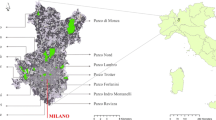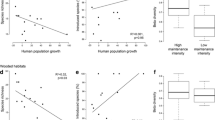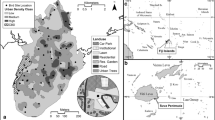Abstract
To evaluate the importance of urban woodlands to serve as potential sites for biodiversity conservation, we analysed bird, carabid beetle and small mammal community responses to urbanisation at different spatial scales. We analysed the relationships between the variations of the structure (species richness S, diversity H′ and dominance D) of animal communities of woodlands distributed along a rural–urban gradient, and the variations along this same gradient of (1) the vegetation within woodlands, (2) the landscape at 100 m and (3) 600 m around the woodlands. We identified the spatial scales whose variations along the gradient most affected each animal community structure, and characterised community responses to these variations. Our results showed that urbanisation affected taxa differently according to their dispersal ability. Carabid beetles, less mobile, seem to be sensitive to increasing fragmentation and built surfaces from periurban to town centre which could make their movement within the urban landscape difficult. Birds, mobile species, seem to be more sensitive to variations of the vegetation structure within woodlands from periurban to town centre that could affect their capacity to maintain in habitat patches. Although our study did not allow relating the small mammal community structure to urbanisation, it suggests that this taxa is sensitive to urban local disturbances. A relevant management scale of woodlands can be specified for each taxa conservation. Urban woodlands accommodate over 50% of the species present in periurban woodlands, and effective management could enhance this number. Woodlands seem to be a good choice for promoting biodiversity conservation in towns.




Similar content being viewed by others
References
Adams LW (1994) Urban wildlife habitats a landscape perspective. University of Minnesota Press, Minneapolis
Andrén H (1994) Effects of habitat fragmentation on birds and mammals in landscape with different proportions of suitable habitat: a review. Oikos 71:355–366. doi:10.2307/3545823
Angold PG, Sadler JP, Hill MO et al (2006) Biodiversity in urban habitat patches. Sci Total Environ 360:196–204. doi:10.1016/j.scitotenv.2005.08.035
Aubry J (1950) Deux pièges pour la capture des petits rongeurs vivants. Mammalia 14:174–177
Baker PJ, Ansell RJ, Dodds PAA et al (2003) Factors affecting the distribution of small mammals in an urban area. Mammal Rev 33:95–100. doi:10.1046/j.1365-2907.2003.00003.x
Bibby CJ, Burgess ND, Hill DA et al (2000) Bird census techniques, 2nd edn. Academic Press, London
Blair RB (1996) Land use and avian species diversity along an urban gradient. Ecol Appl 6:506–519. doi:10.2307/2269387
Bolger DT, Scott TA, Rotenberry JT (1997) Breeding bird abundance in an urbanizing landscape in Coastal Southern California. Conserv Biol 11:406–421. doi:10.1046/j.1523-1739.1997.96307.x
Bowman J, Forbes G, Dilworth T (2001) Landscape context and small-mammal abundance in a managed forest. For Ecol Manage 140:249–255
Brennan SP, Schnell GD (2005) Relationship between bird abundances and landscape characteristics: the influence of scale. Environ Monit Assess 105:209–228. doi:10.1007/s10661-005-3694-x
Burel F, Baudry J, Butet A et al (1998) Comparative biodiversity along a gradient of agricultural landscapes. Acta Oecol 19:47–60. doi:10.1016/S1146-609X(98)80007-6
Butet A, Paillat G, Delettre Y (2006) Factors driving small rodents assemblages from field boundaries in agricultural landscapes of western France. Landsc Ecol 21:449–461. doi:10.1007/s10980-005-4118-6
Clergeau P, Savard JPL, Mennechez G et al (1998) Bird abundance and diversity along an urban-rural gradient: a comparative study between two cities on different continents. Condor 100:413–425. doi:10.2307/1369707
Clergeau P, Jokimäki J, Savard JPL (2001) Are urban bird communities influenced by the bird diversity of adjacent landscapes? J Appl Ecol 38:1122–1134. doi:10.1046/j.1365-2664.2001.00666.x
Clergeau P, Jokimäki J, Snep R (2006) Using hierarchical levels for urban ecology. Trends Ecol Evol 21:660–661. doi:10.1016/j.tree.2006.09.006
de la Millán Peña N, Butet A, Delettre Y et al (2003) Response of the small mammal community to changes in western French agricultural landscapes. Landsc Ecol 18:265–278. doi:10.1023/A:1024452930326
Diaz M, Santos T, Telleria JL (1999) Effects of forest fragmentation on the winter body condition and population parameters of an habitat generalist, the wood mouse Apodemus sylvaticus: a test of hypotheses. Acta Oecol 20:39–49. doi:10.1016/S1146-609X(99)80014-9
Donnelly R, Marzluff JM (2004) Importance of reserve size and landscape context to urban bird conservation. Conserv Biol 18:733–745. doi:10.1111/j.1523-1739.2004.00032.x
Dubois PJ, Le Maréchal P, Olioso G et al (2001) Inventaire des oiseaux de France. Nathan, Paris
Dunford W, Freemark K (2004) Matrix matters: effects of surrounding land uses on forest birds near Ottawa, Canada. Landsc Ecol 20:497–511. doi:10.1007/s10980-004-5650-5
Ericson L, Hansson L, Larsson TB et al (1988) The importance of residual biotopes for fauna and flora. In: Schreiber KF (ed) Proceedings of the 2nd international seminar of the international association for landscape ecology, Munster, 1988
Fenger J (1999) Urban air quality. Atmos Environ 33:4877–4900. doi:10.1016/S1352-2310(99)00290-3
Fernández-Juricic E, Schroeder N (2003) Do variations in scanning behavior affect tolerance to human disturbance? Appl Anim Behav Sci 84:219–234. doi:10.1016/j.applanim.2003.08.004
Germaine SS, Wakeling BF (2001) Lizard species distributions and habitat occupation along an urban gradient in Tucson, Arizona, USA. Biol Conserv 97:229–237. doi:10.1016/S0006-3207(00)00115-4
Gilbert OL (1989) The ecology of urban habitats. Chapman & Hall, Cambridge
Heger T, Trepl L (2003) Predicting biological invasions. Biol Invasions 5:313–321. doi:10.1023/B:BINV.0000005568.44154.12
Ishitani M, Kotze DJ, Niemela J (2003) Changes in carabid beetle assemblages across an urban-rural gradient in Japan. Ecography 26:481–489. doi:10.1034/j.1600-0587.2003.03436.x
Jeannel R (1941) Coleoptères Carabiques, Faune de France. vols 39–40. Librairie de la faculté des sciences, Paris
Jokimäki J, Kaisanlahti-Jokimäki ML (2003) Spatial similarity of urban bird communities: a multiscale approach. J Biogeogr 30:1183–1193. doi:10.1046/j.1365-2699.2003.00896.x
Jokimäki J, Kaisanlahti-Jokimäki ML, Sorace A et al (2005) Evaluation of the “safe nesting zone” hypothesis across an urban gradient: a multi-scale study. Ecography 28:59–70. doi:10.1111/j.0906-7590.2005.04001.x
Kelcey JG, Rheinwald G (2005) Birds in European cities. Ginster Verlag, St. Katharinen
Keller I, Nentwig W, Largiadèr CR (2004) Recent habitat fragmentation due to roads can lead to significant genetic differentiation in an abundant flightless ground beetle. Mol Ecol 13:2983–2994. doi:10.1111/j.1365-294X.2004.02310.x
Kowarik I, Körner S (2005) Wild urban woodlands new perspectives for urban forestry. Springer, Berlin/Heidelberg
Kozakiewicz M, Szacki J (1995) Movements of small mammals in a landscape: patch restriction or nomadism? In: Lidicker WZ (ed) Landscape approaches in mammalian ecology and conservation. University of Minnesota Press, Minneapolis, pp 78–94
Leston LFV, Rodewald AD (2006) Are urban forests ecological traps for understory birds? An examination using Northern cardinals. Biol Conserv 131:566–574. doi:10.1016/j.biocon.2006.03.003
Lim HC, Sodhi NS (2004) Responses of avian guilds to urbanisation in a tropical city. Landsc Urban Plan 66:199–215. doi:10.1016/S0169-2046(03)00111-7
Loram A, Tratalos J, Warren PH et al (2007) Urban domestic gardens (X): the extent and structure of the resource in five major cities. Landsc Ecol 22:601–615. doi:10.1007/s10980-006-9051-9
Magurran AE (1988) Ecological diversity and its measurements. Princeton University Press, Princeton, New Jersey, p 215
Marzluff JM, Ewing K (2001) Restoration of fragmented landscapes for the conservation of birds: a general framework and specific recommendations for urbanizing landscapes. Restor Ecol 9:280–292. doi:10.1046/j.1526-100x.2001.009003280.x
McDonnell MJ, Pickett STA (1990) Ecosystem structure and function along urban–rural gradients: an unexploited opportunity for ecology. Ecology 71:1232–1237. doi:10.2307/1938259
McGarigal K, Cushman SA, Neel MC et al (2002) Fragstats: spatial pattern analysis program for categorical maps. Computer software program, University of Massachusetts, Amherst. http://www.umass.edu/landeco/research/fragstats/fragstats.html
McKinney ML (2006) Urbanisation as a major cause of biotic homogenization. Biol Conserv 127:247–260. doi:10.1016/j.biocon.2005.09.005
Melles S, Glenn S, Martin K (2003) Urban bird diversity and landscape complexity: species–environment associations along a multiscale habitat gradient. Conserv Ecol 7:5 http://www.consecol.org/vol7/iss1/art5
Niemelä J (1999) Ecology and urban planning. Biodivers Conserv 8:119–131. doi:10.1023/A:1008817325994
Niemelä J, Kotze DJ, Venn S et al (2002) Carabid beetle assemblages (Coleoptera, Carabidae) across urban–rural gradients: an international comparison. Landsc Ecol 17:387–401. doi:10.1023/A:1021270121630
Oksanen KJ, O’Hara RB (2005) Vegan: community ecology package. R package version 1.6–9. http://cc.oulu.fi/~jarioksa/
Ormerod SJ (2003) Restoration in applied ecology: editor’s introduction. J Appl Ecol 40:44–50. doi:10.1046/j.1365-2664.2003.00799.x
Sadler JP, Small EC, Fiszpan H et al (2006) Investigating environmental variation and landscape characteristics of an urban–rural gradient using woodland carabid assemblages. J Biogeogr 33:1126–1138. doi:10.1111/j.1365-2699.2006.01476.x
Savard JPL, Clergeau P, Mennechez G (2000) Biodiversity concepts and urban ecosystems. Landsc Urban Plan 48:131–142. doi:10.1016/S0169-2046(00)00037-2
Slabbekoorn H, Pamela Y, Hunt K (2007) Sound transmission and song divergence: a comparison of urban and forest acoustics. Condor 109:67–78. doi:10.1650/0010-5422(2007)109[67:STASDA]2.0.CO;2
Snep RPH, Opdam PFM, Baveco JM et al (2006) How peri-urban areas can strengthen animal populations within cities: a modeling approach. Biol Conserv 127:345–355. doi:10.1016/j.biocon.2005.06.034
Spence JR, Niemelä J (1994) Sampling carabid assemblages with pitfall traps: the madness and the method. Can Entomol 126:881–894
Stoddart DM (1980) Urban small mammals. J Zool 191:403–406
Thioulouse J, Chessel D, Dolédec S et al (1997) ADE-4: a multivariate analysis and graphical display software. Stat Comput 7:75–83. doi:10.1023/A:1018513530268
Verboom B, Van Apeldoorn R (1990) Effects of habitat fragmentation on the red squirrel, Sciurus vulgaris, L. Landsc Ecol 4:171–176. doi:10.1007/BF00132859
Voogt JA, Oke TR (2003) Thermal remote sensing of urban climates. Remote Sens Environ 86:370–384. doi:10.1016/S0034-4257(03)00079-8
Whittaker RH (1967) Gradient analysis of vegetation. Biol Rev Camb Philos Soc 49:207–264. doi:10.1111/j.1469-185X.1967.tb01419.x
Wilcox BA, Murphy DO (1985) Conservation strategy: the effects of fragmentation on extinction. Am Nat 125:879–887. doi:10.1086/284386
Acknowledgments
We thank Patricia Le Quilliec and Vincent Péllissier for assistance in the field, Yannick Delettre and Nadia Michel for their help with statistical analysis, Damien Fourcy, Jérémie Guyon, Yann Rantier, Jean-Baptiste Pichancourt and Laurence Hubert for their advice about GIS, and Tim Legg and Christina Richardson who improved the English. We also thank Dr. Jari Niemelä and three anonymous reviewers for their helpful comments on earlier drafts. This study was carried out as part of the ECORURB Programme (http://www.rennes.inra.fr/ecorurb/). We are also grateful to the city of Rennes and Rennes Métropole for allowing us to carry out our surveys.
Author information
Authors and Affiliations
Corresponding author
Rights and permissions
About this article
Cite this article
Croci, S., Butet, A., Georges, A. et al. Small urban woodlands as biodiversity conservation hot-spot: a multi-taxon approach. Landscape Ecol 23, 1171–1186 (2008). https://doi.org/10.1007/s10980-008-9257-0
Received:
Accepted:
Published:
Issue Date:
DOI: https://doi.org/10.1007/s10980-008-9257-0




